13 Jul 2017 - {{hitsCtrl.values.hits}}
Red alert on Uma Oya project ! Experts rule out complete recovery
Residents left out to dry as third leak continues
WATCH VIDEO
 “Cracks have appeared on the walls of my house where I was living with my wife, my kids and my mother for more than twenty years. There is not a drop of water in our well which used to be full. My vegetable cultivations are destroyed. I have no livelihood now. Farming is all I know. Please sir, help us to live.” This is quoted from a letter written by R.M.Gnanasiri, from Dalukella, Mathetilla of Bandarawela. We met him outside the Bandarawela Divisional Secretary’s Office, where he was waiting to meet the District Secretary (DS) to handover the letter.
“Cracks have appeared on the walls of my house where I was living with my wife, my kids and my mother for more than twenty years. There is not a drop of water in our well which used to be full. My vegetable cultivations are destroyed. I have no livelihood now. Farming is all I know. Please sir, help us to live.” This is quoted from a letter written by R.M.Gnanasiri, from Dalukella, Mathetilla of Bandarawela. We met him outside the Bandarawela Divisional Secretary’s Office, where he was waiting to meet the District Secretary (DS) to handover the letter.
Gnanasiri’s house is just one among thousands of houses subject to cracks due to the adverse effects of Uma Oya Multipurpose Development Project which was initiated in 2008 by an Iranian contractor Farab under the Rajapaksa Government. Five-inch cracks started appearing on the walls of Gnanasiri’s house years ago. His house is located within a distance less than one kilometer from the tunnel. As relief, he still receives a mere Rs. 50 per day for dry rations.
Tunnel excavation work taking place about 700 feet below the surface had caused three huge internal water leaks (the third one is still happening). All the wells and water springs in the area are dried up, causing a severe water shortage, instability of lands and destruction of cultivations and properties of villagers. Due to the third leak, eighty million litres of water per day is wasted.
People complain that not only the previous government, but also the present government is responsible for all the disasters caused by the Uma Oya Project. They claim that the present government is continuing the project in the face of strong public opposition. Apart from facing a catastrophe, the villagers complain about irregularities in the resettlement of displaced villagers and compensation procedure in place.
The issue surfaced again in newspaper headlines last month following a massive demonstration carried out by citizens of Bandarawela against the government’s silent approach towards the impending natural and geological disaster caused by the project.
During a tour of Bandarawela, the Daily Mirror, observed several houses having severe cracks on their walls. The cracks had surfaced three months ago. People are also experiencing hardships due to the availability of only a limited amount of water in the tanks for daily consumption, provided by the Divisional Secretariat’s Office.
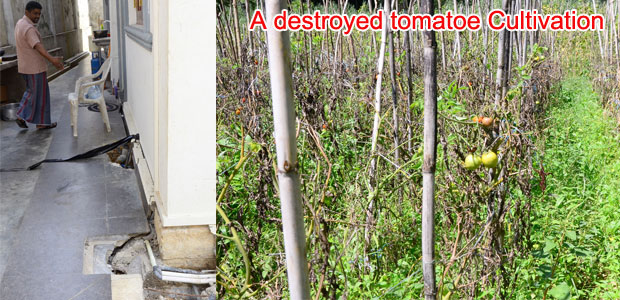
Sixty five percent of the Uma Oya, which starts from Piduruthalagala Mountain, belongs to the Uva Province while 35% belongs to the Central Province. The objective of the Uma Oya Multipurpose Development Project was to construct two dams named Dyraaba and Puhulpola, an underground hydro-electric power generation plant and a tunnel. As planned, the tunnel will connect the dams and transfer water to the power plant which will hopefully add 120 MW to the national electricity grid. The hydro-electric power generation plant will also be directed to the Hambantota dry zone and some dry areas of Wellawaya.
The first huge internal water leak was reported from Makul Ella area. Second one was from Udaperuwa. As a result of the leakages, all the water in water springs and wells seeped into the tunnel. Consequently, all the water springs dried up in Wehagala-thenna, Makul Ella, Heel Oya, Palleruwa and Udaperuwa. The third water leak is still happening, drying up water springs in Keenigama, Bindunu Wewa, Hapugas Ulpatha and Dik Ulpatha. Geologists said the tunneling had damaged the soil structure on the earth. Where ever the soil structure wasn’t stable, cracks appeared and sections of some houses and buildings started sinking.
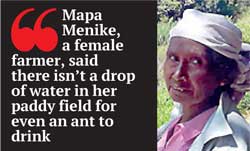 Nilanthi Sanjeewani, a mother of two from Bandarawela, requested President Maithripala Sirisena to pay thorough attention to their problems and order the relevant authorities to bring a solution.
Nilanthi Sanjeewani, a mother of two from Bandarawela, requested President Maithripala Sirisena to pay thorough attention to their problems and order the relevant authorities to bring a solution.
“Temples at Makul Ella, Egodagama, Heel Oya and Kurundu Golla and Palleperuwa Mosque are among the religious places affected. This problem has also affected the education of our children. They also worry about these issues. Cracks have appeared on some buildings of Makul Ella School, Adikaram School and Dharmashoka Central College in Bandarawela. We are afraid to send our children to school given this situation,” she said.
Sixty-five-year old R.M.Sumanawathi said all what is left for them is to pray to God to take them out this trouble and help them to live like before.
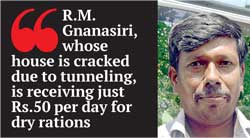 “Water is more valuable than gold. All the neighbors used to take water from our well. After the Uma Oya Project, our well dried up. Distributing water once a week isn’t enough. They will distribute water only as long as the project continues. What will happen after the completion of the project?” she asked.
“Water is more valuable than gold. All the neighbors used to take water from our well. After the Uma Oya Project, our well dried up. Distributing water once a week isn’t enough. They will distribute water only as long as the project continues. What will happen after the completion of the project?” she asked.
Mapa Menike is a female farmer. She said there isn’t a drop of water in her paddy field for even an ant to drink. There are six-inch cracks in her field.
“We used to depend on the earth. Now, we don’t have a livelihood because of what Appachchi (Former President Mahinda Rajapaksa) did merely for his personal benefits. He prioritized only his well-being. That is why we are all helpless now. We have been thrown into a situation where we have to beg on streets,” she said.
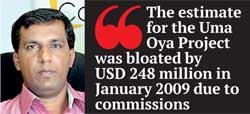 Meanwhile, charging the previous government, CaFFE Executive Director Keerthi Thennakoon said the estimate for the Uma Oya Project was bloated by USD 248 million in January 2009 due to commissions.
Meanwhile, charging the previous government, CaFFE Executive Director Keerthi Thennakoon said the estimate for the Uma Oya Project was bloated by USD 248 million in January 2009 due to commissions.
Issuing a press release recently, he said former Irrigation Ministry Secretary A.D.S.Gunawardena resigned from his post on January 9, 2009 noting his reluctance to sign the project agreement that costs an additional sum of USD 248 million to the Sri Lankan Government.
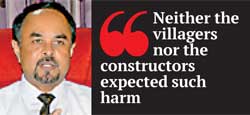 Bandarawela Divisional Secretary G.G.N.Gunaratne said damages began being reported when the excavation of the tunnel began.
Bandarawela Divisional Secretary G.G.N.Gunaratne said damages began being reported when the excavation of the tunnel began.
“A number of landslides occurred on October 29, 2014 in some areas of the Badulla District including Koslanda, killing at least 16 people and leaving around 200 missing. I am unable to verify the environmental connection between the landslides and the geological damage caused by the tunnel excavation of the Uma Oya Project. I doubt there is a connection. It was on December 26, 2014, that all the damages were done to houses, two days after the first water leakage,” he explained.
According to him, neither the villagers nor the constructors expected such damage and therefore constructors failed to address the issue and act properly.
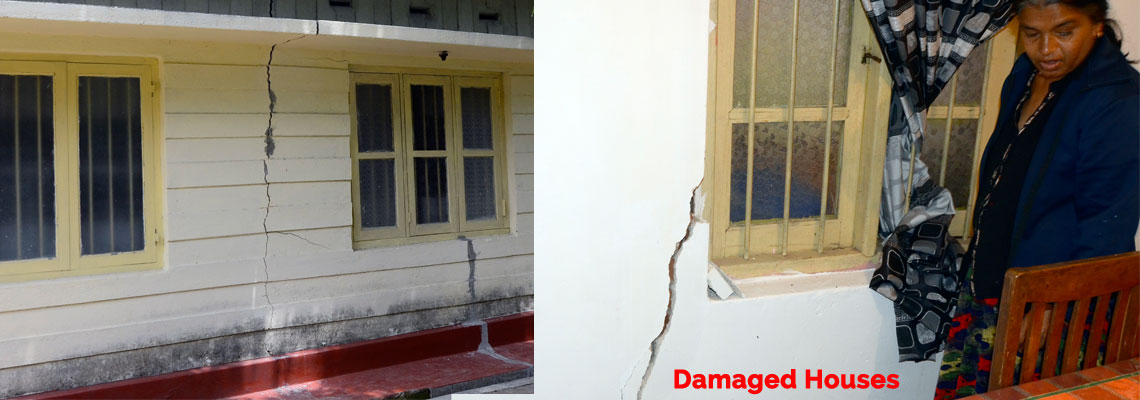
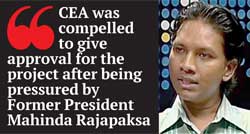 Meanwhile, the Head of Geology Department of Peradeniya University Professor Jagath Goonatilake said it’s a huge waste of funds and effort if a decision is taken to terminate the project after completing more than 70 percent of it.
Meanwhile, the Head of Geology Department of Peradeniya University Professor Jagath Goonatilake said it’s a huge waste of funds and effort if a decision is taken to terminate the project after completing more than 70 percent of it.
“We are giving instructions to them on how to minimize the harm. It is pointless to terminate the project now. Wrong areas need to be corrected so that the constructors can continue with the rest of the project,” he said.
The Director of Environment Conservation Trust, Sajeewa Chamikara said that the project was initiated to provide water for development projects launched by the Rajapaksa Government in the Hambantota District. He claimed that the Central Environment Authority (CEA) was compelled to give approval for the project after being pressurized by Former President Mahinda Rajapaksa despite the CEA identifying the potential harm.
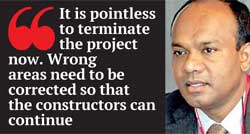 Chamikara said that a number of small irrigational and hydro-electric projects operated from the water of the Uma Oya are under risk. “Uma Oya water also feeds the Rantambe Reservoir and the Bathmedilla Project. All these projects are also under risk due to the transfer of water from Uma Oya through the Iran funded project,” he said. He emphasized that ultimately there will be a decrease in the number of rice and vegetables being cultivated in the areas affected by the Uma Oya Project. Chamikara was of the view that the fundamental human rights of people who use water under the Mahaweli Project are also being violated. “At this rate, the government will have to allocate more money to supply water to such agricultural work in the absence of water from Uma Oya,” he said.
Chamikara said that a number of small irrigational and hydro-electric projects operated from the water of the Uma Oya are under risk. “Uma Oya water also feeds the Rantambe Reservoir and the Bathmedilla Project. All these projects are also under risk due to the transfer of water from Uma Oya through the Iran funded project,” he said. He emphasized that ultimately there will be a decrease in the number of rice and vegetables being cultivated in the areas affected by the Uma Oya Project. Chamikara was of the view that the fundamental human rights of people who use water under the Mahaweli Project are also being violated. “At this rate, the government will have to allocate more money to supply water to such agricultural work in the absence of water from Uma Oya,” he said.
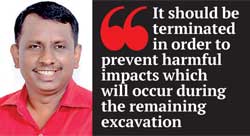 Janatha Vimukthi Peramuna (JVP) member for Uva Provincial Council Samantha Vidyarathna said regardless of the efforts taken and funds spent on the Uma Oya Project thus far, it should be terminated in order to prevent harmful impacts which will occur during excavation of the remaining 5.5km of the tunnel.
Janatha Vimukthi Peramuna (JVP) member for Uva Provincial Council Samantha Vidyarathna said regardless of the efforts taken and funds spent on the Uma Oya Project thus far, it should be terminated in order to prevent harmful impacts which will occur during excavation of the remaining 5.5km of the tunnel.
Following are the demands presented by Uva PC member Vidyarathna to the government.
Last week, the Mahaweli Development and Environment Ministry announced the suspension of drilling operations in the Uma Oya Project for a period of ten days until a solution was found for the water leakage.
It was also reported that drilling machinery utilising modern technology will be flown in from Switzerland before July 18.
The suspension came after President Maithripala Sirisena summoned those involved in the Uma Oya Project for a meeting in an attempt to find a solution to the situation that has arisen in the area surrounding the project.
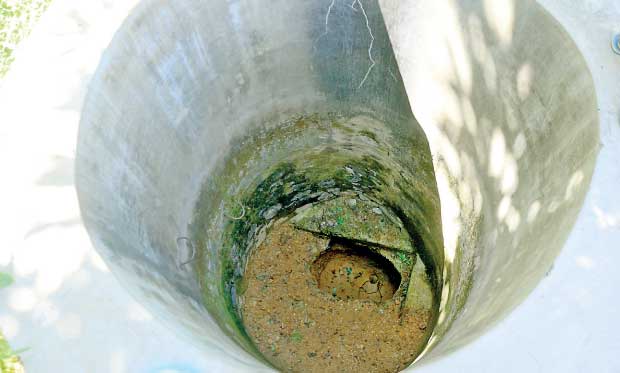
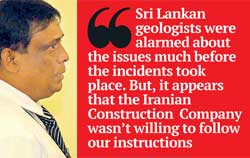 Professor in Geology at University of Peradeniya H.A Dharmagunawardena when contacted by the Daily Mirror said the natural and geological damage caused by the Uma Oya tunnelling is so immense that a complete recovery of the disaster was impossible.
Professor in Geology at University of Peradeniya H.A Dharmagunawardena when contacted by the Daily Mirror said the natural and geological damage caused by the Uma Oya tunnelling is so immense that a complete recovery of the disaster was impossible.
“Water leaks are inevitable when excavating a tunnel. But, the issue with the Uma Oya Project is that the water leaks are so heavy that they get out of control. This is the first time such a tunnelling method has been used in Sri Lanka. Fixing the leak is extremely difficult with this tunnelling method because there’s no direct access to the leak.
“The tunnel stretches several hundreds of metres below the surface. The hydraulic pressure that it creates in water columns above the grounds, where leaks have occurred, is enormous. These leakages suck the water from the shallow ground into the tunnel causing a declension of ground water level at the surface. As a consequence, the areas go dry and all social and environmental damages occur. Ground water recharge in the future will be at a very low level. If the tunnel isn’t completely sealed off, the water will leak even after the tunnel is filled with water.
“Unfortunately, millions of litres of water that leaked into the tunnel were removed from the water springs. Our people have destroyed these precious resources of water which could have been preserved for years. The damage will be permanent. The workers will be able to rectify only a part of the damage, but not fully.
“Sri Lankan geologists were alarmed about the issues much before the incidents took place. But, it appears that the Iranian Construction Company wasn’t willing to follow our instructions. Despite all the disasters that have taken place, it seems that the authorities still don’t lend an ear to the advice of professional geologists’. That is why they are now seeking assistance from abroad to fix the leaks.
“When local expert panels studied the first leak which occurred in 2014, they warned that there would be more leaks. Unfortunately, our advice wasn’t heeded by the constructors. There have been recommendations and meetings to raise the awareness about the possible impacts of the unhealthy tunnelling carried out using sub-standard machinery. It poses a question whether these recommendations were followed.
“The feasibility study carried out on the project hasn’t foreseen the problems adequately. Ground water won’t fill up again as before due to the absence of the previous pressure. Even after the leaks, it will take years for the dried water springs to fill.

“If the tunnel is going to proceed like this, I think there will be many problems. There will be many leakages if the tunnelling continues without appropriate measures being taken.
A thorough pre-tunnelling investigation should be launched to detect the potential threats that will surface with the proceedings of the tunnel. The ground areas must be stabilized before starting further excavations. However, even if the leakages are rectified somehow, what is the guarantee we can have that there won’t be more leakages?
Pix by Waruna Wanniarachchi
23 Dec 2024 29 minute ago
23 Dec 2024 2 hours ago
23 Dec 2024 2 hours ago
23 Dec 2024 2 hours ago
23 Dec 2024 4 hours ago